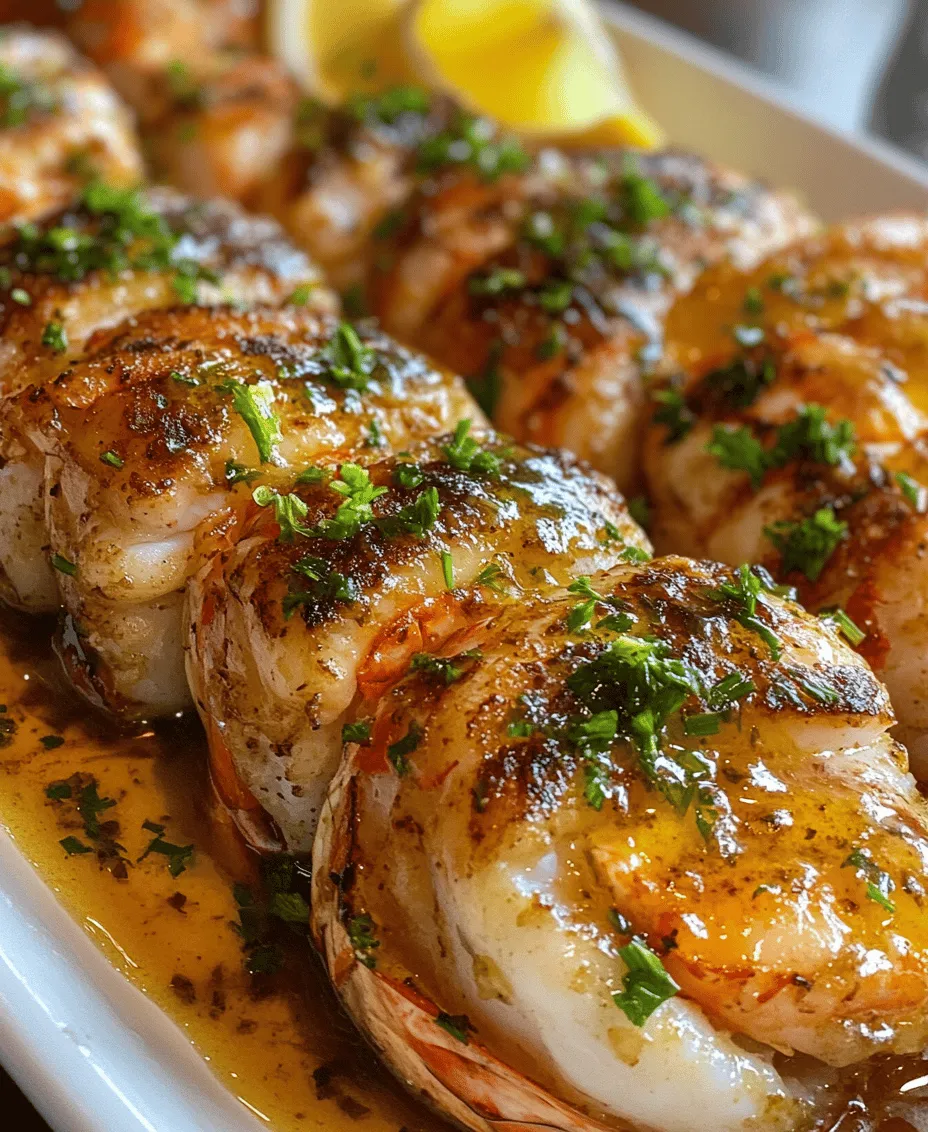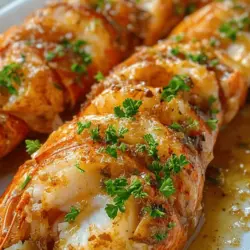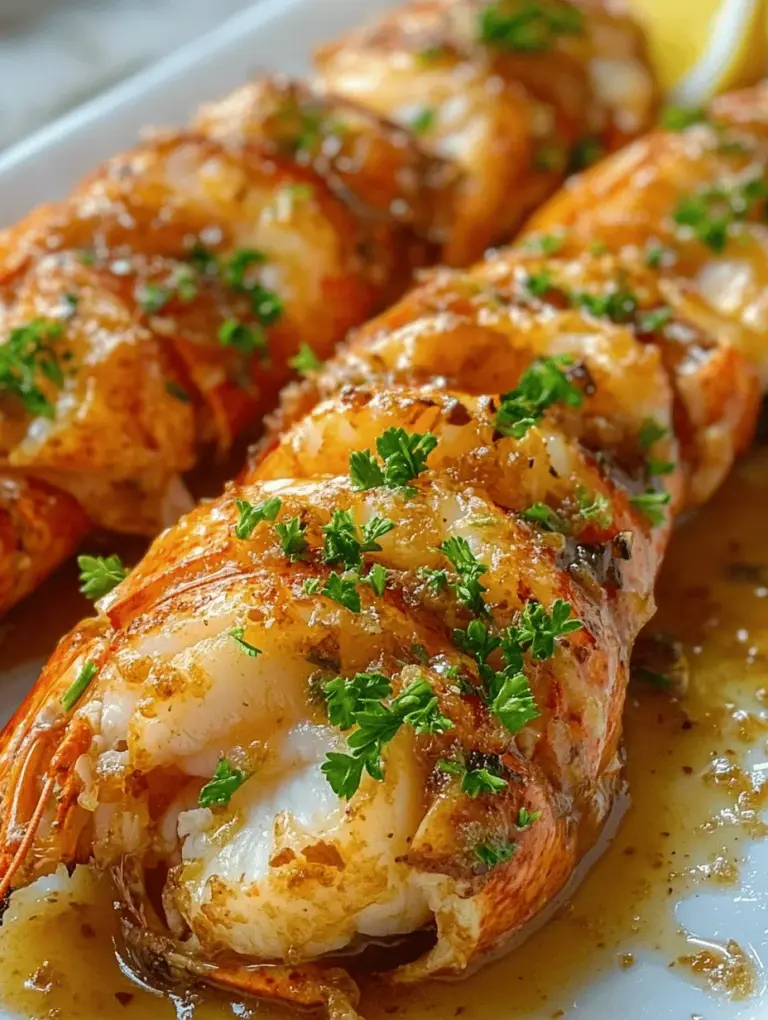Indulging in a plate of butter-poached lobster tails is a culinary experience that transports you to the shores of New England, where fresh seafood reigns supreme. This exquisite dish not only highlights the delicate flavor of lobster but also showcases the richness of butter infused with aromatic herbs and spices. The process of butter-poaching is a gentle cooking technique that ensures the lobster remains tender and succulent, while the infused butter adds a depth of flavor that elevates the dish to new heights.
Whether you’re hosting a special occasion, impressing guests at a dinner party, or simply treating yourself to a luxurious meal, this recipe is sure to impress. The allure of butter-poached lobster tails lies not only in their taste but also in the way they embody the essence of fine dining, making them a perfect centerpiece for any gourmet meal.
Understanding Lobster Tails
Overview of Lobster Species
When it comes to lobster tails, the two most commonly used species are the Maine lobster (Homarus americanus) and the spiny lobster (Panulirus argus). Maine lobsters are known for their sweet, tender meat and are often the preferred choice for butter-poaching. They have large claws and are typically found in the cold waters of the North Atlantic. On the other hand, spiny lobsters lack claws and are more abundant in warmer waters, offering a slightly different flavor profile that can also be delightful in various dishes.
Both species provide a rich source of culinary inspiration, but for this recipe, we will focus on the Maine lobster due to its renowned flavor and texture. Whichever type you choose, always aim for high-quality, fresh lobster tails to ensure the best results.
Nutritional Benefits of Lobster
Lobster is not only a treat for the taste buds but also a nutritious addition to your diet. It is low in calories and high in protein, making it a great option for those looking to indulge without overindulging. Additionally, lobster is rich in essential vitamins and minerals, including:
– Vitamin B12: Important for nerve function and the production of DNA and red blood cells.
– Selenium: A powerful antioxidant that helps protect cells from damage.
– Omega-3 Fatty Acids: Beneficial for heart health and reducing inflammation.
– Zinc: Supports immune function and overall health.
By choosing lobster as part of your meal, you’re not only enjoying a luxurious dish but also reaping its nutritional benefits.
Selecting Fresh Lobster Tails
Selecting the freshest lobster tails is crucial for achieving the best flavor and texture in your butter-poached dish. Here are some tips for identifying quality lobster tails:
– Look for Bright Color: Fresh lobster tails should have a vibrant color, indicating freshness. Avoid tails that are dull or discolored.
– Check for Firmness: The meat should feel firm to the touch. If it feels mushy or soft, it may not be fresh.
– Smell the Ocean: Fresh lobster should have a clean, briny smell reminiscent of the ocean. A strong, unpleasant odor is a sign that the lobster is not fresh.
– Consider Sizing: Lobster tails come in various sizes, typically ranging from 4 to 10 ounces. For butter-poaching, medium to large tails (6-8 ounces) are ideal, providing a good amount of meat while still cooking evenly.
When shopping, consider purchasing from reputable seafood markets or suppliers to ensure you are getting the best quality lobster tails available.
The Allure of Butter-Poaching
What is Butter-Poaching?
Butter-poaching is a cooking technique that involves gently cooking food in melted butter, allowing it to absorb the rich flavors while maintaining moisture and tenderness. This method is particularly well-suited for delicate proteins like lobster, as it prevents overcooking and enhances the natural sweetness of the seafood. The result is an incredibly succulent and flavorful dish that melts in your mouth.
Benefits of Butter-Poaching Lobster
Butter-poaching offers several advantages when it comes to preparing lobster tails:
1. Enhanced Flavor: The butter infuses the lobster with rich, savory notes while allowing the natural sweetness of the meat to shine through.
2. Tender Texture: This gentle cooking method ensures that the lobster meat remains tender and juicy, avoiding the rubbery texture that can occur with high heat.
3. Versatility: Butter-poaching can be easily customized with various herbs, spices, and aromatics, allowing you to tailor the flavor profile to your liking.
Flavor Profiles and Aroma Enhancements
The flavor profile of butter-poached lobster can be further enhanced by incorporating a variety of aromatics and seasonings. Common additions include:
– Garlic: Adds a savory depth and a hint of warmth.
– Shallots: Provide a subtle sweetness that complements the lobster.
– Thyme: Offers a fresh, herbal note that balances the richness of the butter.
– Citrus: Lemon juice and zest brighten the dish and enhance the overall flavor.
By experimenting with different combinations of these ingredients, you can create a butter-poached lobster dish that is uniquely yours.
Ingredients Breakdown
Fresh Lobster Tails: Choosing the Right Size and Quality
As mentioned earlier, selecting high-quality lobster tails is essential. Opt for fresh, sustainably sourced Maine lobster tails for the best flavor and texture. The size of the tails can vary, so pick ones that suit your serving needs, typically between 6 to 8 ounces for individual servings. Ensure that the tails are intact, with no signs of damage or discoloration.
The Role of Unsalted Butter in the Recipe
Unsalted butter is the star of this recipe, as it provides the base for poaching the lobster. Using unsalted butter allows you to control the seasoning more precisely, ensuring that the natural flavors of the lobster are not overwhelmed. The butter should be of high quality – look for brands that use cream from grass-fed cows for the best taste and richness.
Essential Aromatics: Garlic, Shallots, and Thyme
The right aromatics can elevate your butter-poached lobster to new heights. Here’s a closer look at the essential components:
– Garlic: Fresh garlic cloves, minced or crushed, will infuse the butter with a rich, aromatic flavor.
– Shallots: Finely chopped shallots add a mild sweetness and depth to the dish.
– Thyme: Fresh thyme sprigs lend an earthy, herbal note that pairs beautifully with the lobster.
The Importance of Citrus: Lemon Juice and Zest
Citrus is a crucial component in balancing the richness of the butter and the sweetness of the lobster. Fresh lemon juice adds acidity, while lemon zest contributes a burst of bright flavor. Together, they enhance the overall taste of the dish, making it more vibrant and refreshing.
Seasoning: Salt and White Pepper for Balance
While the butter and aromatics provide the primary flavor, seasoning is essential for achieving balance. A pinch of salt enhances the overall taste, while white pepper adds a subtle warmth without overpowering the dish. Be mindful not to over-season, as the goal is to highlight the lobster’s natural sweetness.
Garnishing with Fresh Parsley and Lemon Wedges
A finishing touch of fresh parsley adds color and a hint of bitterness that contrasts beautifully with the richness of the butter. Lemon wedges served alongside the dish provide an extra burst of acidity, allowing diners to customize their experience to their liking.
Step-by-Step Instructions
Now that we’ve covered the essential aspects of butter-poached lobster tails, it’s time to delve into the step-by-step instructions for preparing this luxurious dish.
Preparing the Lobster Tails
Before you begin cooking, it’s important to properly prepare the lobster tails. Start by thawing them if they are frozen; this can be done by placing them in the refrigerator overnight or running them under cold water for a couple of hours. Once thawed, use kitchen scissors to carefully cut the top shell of the lobster tail lengthwise, stopping just before the tail fin. This will allow you to easily lift the meat out while maintaining its shape.
Tools You’ll Need: Kitchen Scissors and Cutting Board
To prepare the lobster tails effectively, you’ll need a few essential tools:
– Kitchen Scissors: These are perfect for cutting through the tough shell of the lobster tail without damaging the meat.
– Cutting Board: A sturdy cutting board will provide a stable surface for your preparation.
Techniques for Cutting and Lifting the Meat
Once you have cut the shell, gently lift the lobster meat out, keeping it attached at the tail end. This presentation not only looks elegant but also allows for even cooking. If desired, you can also gently press the meat down to rest on top of the shell, making it easier to coat in butter during the poaching process.
Seasoning Tips for Optimal Flavor
Before poaching, season the lobster meat lightly with salt and white pepper. This step enhances the flavor and ensures that each bite is perfectly seasoned, allowing the natural sweetness of the lobster to shine through.
Making the Butter Mixture
In a saucepan, combine the unsalted butter, minced garlic, chopped shallots, and thyme. Gently heat the mixture over low to medium-low heat until the butter is completely melted and the aromatics are softened but not browned. This infusion process is key to achieving a richly flavored butter that will coat the lobster tails beautifully.
Melting the Butter: Temperature Control
Temperature control is crucial when melting the butter. You want it to melt gently without overheating, as high temperatures can cause the butter to burn and develop off-flavors. Monitor the heat closely and adjust as necessary to maintain a low simmer throughout the cooking process.
With the introduction to butter-poached lobster tails, an understanding of its components, and a clear outline of the initial steps, you are well on your way to mastering this luxurious seafood dish. Stay tuned for the next part, where we will continue to explore the remaining steps and tips for achieving the perfect butter-poached lobster tails.

Infusing Flavors: The Art of Combining Ingredients
The magic of butter-poached lobster tails lies not only in the cooking method but also in the flavors you can infuse into the butter. To create a rich, aromatic base, consider adding aromatics such as minced garlic, shallots, or even a splash of white wine. Fresh herbs like thyme, tarragon, or parsley can elevate the flavor profile, imparting freshness and complexity to the dish. Simply toss these ingredients into the melted butter before poaching the lobster tails. Allow them to steep for a few minutes, letting their flavors meld together beautifully.
Achieving the Right Consistency for Poaching
When poaching lobster tails, achieving the perfect consistency for the butter is crucial. The butter should be melted but not bubbling aggressively; this means it should be around 160-180°F (71-82°C). A gentle simmer is ideal. If the butter is too hot, the lobster can become rubbery, while butter that is not warm enough will not cook the lobster properly. Using a thermometer can help maintain the right temperature, ensuring that the lobster tails are tender and juicy.
Poaching the Lobster
Once your butter is infused and at the proper temperature, it’s time to poach the lobster tails. Carefully place the lobster tails into the warm butter, ensuring they are fully submerged. If your pot isn’t large enough to accommodate all the tails at once, poach them in batches. Poaching should take about 8-12 minutes, depending on the size of the tails. The lobster is done when its flesh turns opaque and the internal temperature reaches 140°F (60°C). Avoid overcooking, as this can lead to a chewy texture.
Temperature Management: Keeping the Butter Warm
Maintaining the right temperature throughout the cooking process is essential. If you’re poaching multiple batches of lobster tails, keep the butter warm on low heat while you work. You can also transfer the poached tails to a warm oven (around 170°F/77°C) to keep them warm without further cooking. This ensures that every tail is served at the perfect temperature, enhancing the overall dining experience.
Timing the Cooking Process: Ensuring Perfectly Cooked Lobster
Timing is key when poaching lobster tails. As previously mentioned, the cooking time typically ranges from 8-12 minutes, but various factors can influence this. The size of the lobster tails and the type of pot used can affect cooking times. A good rule of thumb is to check the lobster at the 8-minute mark, especially for smaller tails. The lobster is perfectly cooked when it turns a bright white color and has a slight bounce when pressed gently.
Techniques for Basting: Enhancing Flavor and Texture
Basting is a technique that can take your butter-poached lobster to the next level. During the cooking process, use a spoon to drizzle the warm butter over the lobster tails every few minutes. This not only enhances the flavor but also helps keep the meat moist and tender. The basting process allows the butter to infuse into the lobster, resulting in a rich, buttery taste that perfectly complements the natural sweetness of the lobster.
Finishing Touches and Serving
Once your lobster tails are perfectly poached, it’s time to serve. Carefully remove them from the butter using tongs, letting any excess butter drip off. You can also strain the poaching liquid to remove any solid aromatics, then drizzle this flavored butter over the plated lobster tails for added richness. A sprinkle of fresh herbs or a squeeze of lemon juice can add a refreshing contrast, brightening the dish and enhancing the presentation.
Draining and Plating the Lobster Tails
For a stunning presentation, consider how you plate the lobster tails. Arrange the tails on a large serving platter or individual plates. If you’ve split the tails open for easier access, lay them flat to display the tender meat. Draining excess butter is important, as too much can make the dish overly rich. Use a slotted spoon to transfer the tails, or gently shake them to remove any excess before plating.
Creating an Attractive Presentation
A visually appealing dish can set the stage for a memorable meal. To create an attractive presentation, consider garnishing with fresh herbs like parsley or chives. Edible flowers can add a touch of elegance, and a lemon wedge on the side provides a pop of color and a tangy balance to the rich lobster. You can also drizzle additional infused butter around the plate for a restaurant-quality touch.
Suggested Pairings for a Complete Meal Experience
To complement the luxurious taste of butter-poached lobster tails, consider pairing them with sides that enhance the overall dining experience. Here are some suggestions:
Creative Twists on the Basic Recipe
While the classic butter-poached method is divine, you can get creative with flavors. Consider adding a hint of spice with chili flakes or smoked paprika to your butter for a subtle kick. Incorporating these spices not only adds complexity but also caters to those who enjoy a bit of heat with their seafood.
Using Different Herbs: Basil or Dill Alternatives
Experimenting with different herbs can yield delightful results. Instead of the traditional thyme or parsley, try using basil for a fresh, aromatic profile, or dill for a more delicate flavor. Both herbs work beautifully with lobster and can be infused into the butter during the poaching process.
Ideal Side Dishes to Serve with Butter-Poached Lobster
1. Light Salads for Refreshing Contrast: A simple arugula or mixed greens salad with a lemon vinaigrette can offer a refreshing contrast to the richness of the lobster.
2. Creamy Risottos or Garlic Mashed Potatoes: A creamy risotto, perhaps flavored with lemon or parmesan, pairs beautifully with the buttery lobster. Alternatively, garlic mashed potatoes can provide a comforting, indulgent side.
3. Grilled Asparagus or Seasonal Vegetables: Bright, seasonal vegetables, especially grilled asparagus or sautéed seasonal greens, add color and a healthy balance to your plate.
The Perfect Occasion for Butter-Poached Lobster Tails
Butter-poached lobster tails are ideal for a range of special occasions. Here are a few scenarios where this dish truly shines:
Celebrating Special Occasions: Birthdays, Anniversaries, and Holidays
Lobster tails are synonymous with celebration and luxury. Whether it’s a birthday, anniversary, or holiday feast, serving butter-poached lobster can elevate the meal and create lasting memories. The rich, buttery flavor makes it a standout dish that will impress your guests.
Hosting a Luxurious Dinner Party: Tips for Entertaining
If you’re hosting a dinner party, butter-poached lobster tails can be the centerpiece of a sophisticated menu. Pair them with a selection of fine wines and elegant appetizers to create a well-rounded dining experience. Prepare as much as possible in advance to allow you to enjoy the evening with your guests.
Romantic Dinners: Setting the Mood with Lobster
For a romantic dinner, few things can compete with the allure of butter-poached lobster tails. Set the table with candles, soft music, and a beautifully plated lobster dish to create an intimate ambiance. The luxurious flavors and presentation will certainly impress your partner, making for a memorable evening.
Conclusion
Butter-poached lobster tails are a luxurious yet approachable dish that offers a taste of gourmet dining at home. By mastering the techniques outlined, you can create a dish that not only pleases the palate but also impresses your guests. The simplicity of the ingredients combined with the elegance of the preparation makes this recipe a must-try for any seafood lover. Enjoy the journey of cooking and savor the delicious results of your culinary efforts. With careful attention to detail, flavor infusion, and thoughtful pairings, butter-poached lobster tails can become your go-to dish for any special occasion, transforming any meal into a celebration.

